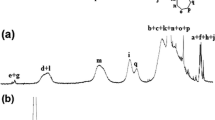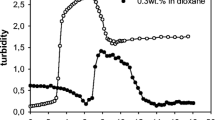Abstract
Well-defined linear dihydrophilic amphiphilic ABA-type triblock copolymers of ε-caprolactone (CL) and N-isopropylacrylamide (NIPAAm) have successfully been synthesized with a high yield by combining the ring opening polymerization (ROP) and xanthate-mediated reversible addition-fragmentation chain transfer (RAFT) polymerization methods. The resulted block copolymer shows the formation of micelles in water as supported by light scattering. The critical micelle concentration (cmc) value of the micelle increases with the increase in the chain length of the poly (N-isopropylacrylamide) (PNIPAAm) block. Cloud point of the block copolymers decreases with the decrease in the PNIPAAm chain length. The TGA analysis shows a one-step degradation and a lower thermal stability of the triblock copolymer than the PNIPAAm. The DSC analysis of the triblock copolymer shows the lowering of glass transition temperature (T g), and melting temperature (T m) peaks possibly due to the partial miscibility of the poly (ε-caprolactone) (PCL) block with the amorphous PNIPAAm block through the interaction of ester groups of PCL with the amide groups of PNIPAAm. The XRD pattern of the triblock copolymer shows a broad peak due to the suppression of the crystallization of PCL block owing to the mixing of PNIPAAm block with the PCL block.











Similar content being viewed by others
References
Ouchi M, Terashima T, Sawamoto M (2009) Transition metal-catalyzed living radical polymerization: toward perfection in catalysis and precision polymer synthesis. Chem Rev 109:4963–5050
Yamago S (2009) Precision polymer synthesis by degenerative transfer controlled/living radical polymerization using organotellurium, organostibine, and organobismuthine chain transfer agents. Chem Rev 109:5051–5068
Almgren M, Brown W, Hvidt S (1995) Self-aggregation and phase behavior of poly (ethylene oxide )-poly (propylene oxide)-poly (ethylene oxide) block copolymers in aqueous solution. Colloid Polym Sci 273:2–15
Alexandridis P, Holzwarth JF (1997) Differential scanning calorimetry investigation of the effect of salts on aqueous solution properties of an amphiphilic block copolymer (Poloxamer). Langmuir 13:6074–6082
Stephan F, Markus A (1998) Amphiphilic block copolymers in structure-controlled nanomaterial hybrids. Adv Mater 10:195–217
Alexandridis P, Nivaggioli T, Hatton TA (1995) Temperature effects on structural properties of Pluronic P104 and F108 PEO-PPO-PEO block copolymer solutions. Langmuir 11:1468–1476
Kedar U, Phutane P, Shidhaye S, Kadam V (2010) Advances in polymeric micelles for drug delivery and tumor targeting. Nanomed Nanotechnol Biol Med 6:714–729
Lee H, Lee E, Kim DK, Jang NK, Jeong YY, Jon S (2006) Antibiofouling polymer-coated superparamagnetic iron oxide nanoparticles as potential magnetic resonance contrast agents for in vivo cancer imaging. J Am Chem Soc 128:7383–7389
Chen H, Wu X, Duan H, Wang YA, Wang L, Zhang M, Mao H (2009) Biocompatible polysiloxane-containing diblock copolymer PEO-b-PgammaMPS for coating magnetic nanoparticles. ACS Appl Mater Interfaces 10:2134–2140
Shin W-J, Basarir F, Yoon T-H, Lee J-S (2009) Au-coated 3-D nanoporous titania layer prepared using polystyrene-b-poly (2-vinylpyridine) block copolymer nanoparticles. Langmuir 25:3344
Callewaert M, Gohy JF, Dupont-Gillain Ch C, Boulang-Petermann L, Rouxhet PG (2005) Surface morphology and wetting properties of surfaces coated with an amphiphilic diblock copolymer. Surf Sci 575:125–135
Perelstein OE, Ivanov VA, Moller M, Potemkin II (2010) Designed AB copolymers as efficient stabilizers of colloidal particles. Macromolecules 43:5442–5449
Bulychev NA, Arutunov IA, Zubov VP, Verdonck B, Zhang T, Goethals EJ, Du Prez FE (2004) Block copolymers of vinyl ethers as thermo-responsive colloidal stabilizers of organic pigments in aqueous media. Macromol Chem Phys 205:24–63
Sakai T, Alexandridis P (2005) Spontaneous formation of gold nanoparticles in poly (ethylene oxide)-poly (propylene oxide) solutions: solvent quality and polymer structure effects. Langmuir 21:8019–8025
Hirokawa Y, Tanaka T (1984) Volume phase transition in a nonionic gel. J Chem Phys 81:6379–6380
Heskins M, Guillet JE (1968) Solution properties of poly(N-isopropylacrylamide). J Macromol Sci, Chem A2(8):1441–1455
Fujishige S, Kubota K, Ando I (1989) Phase transition of aqueous solutions of poly (N-isopropylacrylamide) and poly (N-isopropylmethacrylamide). J Phys Chem 93:3311–3313
Tong Z, Zeng F, Zheng X, Sato T (1999) Inverse molecular weight dependence of cloud points for aqueous poly (N-isopropylacrylamide) solutions. Macromolecules 32:4488–4490
de Azevedo RG, Rebelo LPN, Ramos AM, Szydlowski J, de Sousa HC, Klein J (2001) Phase behaviour of (polyacrylamides + water) solutions: concentration, pressure and isotope effects. Fluid Phase Equilib 185:189–198
Ray B, Isobe Y, Morioka K, Habaue S, Okamoto Y, Kamigaito M, Swamoto M (2003) Synthesis of isotactic poly (N-isopropylacrylamide) by RAFT polymerization in the presence of Lewis acid. Macromolecules 36:543–545
Ray B, Isobe Y, Matsumoto K, Habaue S, Okamoto Y, Kamigaito M, Swamoto M (2004) RAFT polymerization of N-Isopropylacrylamide in the absence and presence of Y (OTf)3: simultaneous control of molecular weight and tacticity. Macromolecules 37:1702–1710
Ray B, Okamoto Y, Kamigaito M, Swamoto M, Seno K, Kanoka S, Aoshima S (2005) Effect of tacticity of poly (N-isopropylacrylamide) on the phase separation temperature of its aqueous solutions. Polym J 37:234–237
Biswas CS, Patel VK, Vishwakarma NK, Mishra AK, Saha S, Ray B (2010) Synthesis and characterization of stereocontrolled poly(N-isopropylacrylamide) hydrogel prepared in the presence of Y (OTf)3 Lewis acid. Langmuir 26:6775–6782
Biswas CS, Patel VK, Vishwakarma NK, Tiwari VK, Maiti P, Kamigaito M, Okamoto Y, Ray B (2011) Effects of tacticity and molecular weight of poly (N-isopropylacrylamide) on its glass transition temperature. Macromolecules 44:5822–5824
Choi C, Chae SY, Nah J-W (2006) Thermosensitive poly (N-isopropylacrylamide)-b-poly (ε-caprolactone) nanoparticles for efficient drug delivery system. Polymer 47:4571–4580
Chang C, Wei H, Quan C-Y, Li Y-Y, Liu J, Wang Z-C, Cheng S-X, Zhang X-Z, Zhuo R-X (2008) Fabrication of thermosensitive PCL-PNIPAAm-PCL triblock copolymeric micelles for drug delivery. J of Polymer Science: Part A: Polymer Chemistry 46:3048–3057
Chen W-Q, Wei H, Li S-L, Feng J, Nie J, Zhang X-Z, Zhuo R-X (2008) Fabrication of star-shaped, thermo-sensitive poly (N-isopropylacrylamide)–cholic acid–poly (3-caprolactone) copolymers and their self-assembled micelles as drug carriers. Polymer 49:3965–3972
Xu FJ, Li J, Yuan SJ, Zhang ZX, Kang ET, Neoh KG (2008) Thermo-responsive porous membranes of controllable porous morphology from triblock copolymers of polycaprolactone and poly (N-isopropylacrylamide) prepared by atom transfer radical polymerization. Biomacromolecules 9:331–339
Li L, Yang X, Liu F, Shang J, Yan G, Li W (2009) Thermosensitive poly (N-isopropylacrylamide)-b-polycaprolact one-b-poly (N-isopropylacrylamide) triblock copolymers prepared via atom transfer radical polymerization for control of cell adhesion and detachment. J Chil Chem Soc 54:4
Wan X, Liu T, Liu S (2011) Synthesis of amphiphilic tadpole-shaped linear-cyclic diblock copolymers via ring-opening polymerization directly initiating from cyclic precursors and their application as drug nanocarriers. Biomacromolecules 12:1146–1154
Patel VK, Mishra AK, Viswakarma NK, Biswas CS, Ray B (2010) (S)-2-(ethyl propionate)-(O-ethyl xanthate) and (S)-2-(ethyl isobutyrate)-(O-ethyl xanthate)-mediated RAFT polymerization of N-vinylpyrrolidone. Polym Bull 65:97–110
Mishra AK, Patel VK, Viswakarma NK, Biswas CS, Raula M, Misra A, Mandal TK, Ray B (2011) Synthesis of well-defined amphiphilic poly (ε-caprolactone)-b-poly (N-vinylpyrrolidone) block copolymers via the combination of ROP and xanthate-mediated raft polymerization. Macromolecules 44:2465–2473
Paira TK, Banerjee S, Raula M, Kotal A, Si S, Mandal TK (2010) Peptide-polymer bioconjugates via atom transfer radical polymerization and their solution aggregation into hybrid micro/nanospheres for dye uptake. Macromolecules 43:4050–4061
Ramesh K, Mishra AK, Patel VK, Viswakarma NK, Biswas CS, Paira TK, Mandal TK, Maiti P, Misra N, Ray B (2012) Synthesis of well-defined amphiphilic poly (d, l-Lactide)-b-poly (N-vinylpyrrolidone) block copolymers using ROP and xanthate-mediated RAFT polymerization. Polymer 53:5743–5753
Štěpánek P, (1993) In dynamic light scattering—the method and some applications; Brown, W., Ed.; Clarendon: Boston; pp177-241.
Chu B (1991) Laser light scattering: basic principles and practices; 2nd ed. Academic, New York, p 1361
Cheng J, Ding J-X, Wang Y-C, Wang J (2008) Synthesis and characterization of star-shaped block copolymer of poly-(ε-caprolactone) and poly(ethyl ethylene phosphate) as drug carrier. Polymer 49:4784–4790
Sheng YJ, Wang TY, Chen WM, Tsao HK (2007) A-B diblock copolymer micelles: effects of soluble-block length and component compatibility. J Phys Chem B 111:10938–10945
Forster S, Zisens M, Wenz E, Antonietti M (1996) Micellization of strongly segregated block copolymers. J Chem Phys B 104:9956–9970
Chung TW, Cho KY, Lee HC, Nah JW, Yeo JH, Akaike T, Cho CS (2004) Novel micelle-forming block copolymer composed of poly (ε-caprolactone) and poly (vinyl pyrrolidone). Polymer 45:1591–1597
Persenaire O, Alexandre M, Degee P, Dubois P (2001) Mechanisms and kinetics of thermal degradation of poly (ε-caprolactone). Biomacromolecules 2:288–294
Kim SJ, Park SJ, Kim IY, Chung TD, Kim HC, Kim SI (2003) Thermal characteristics of interpenetrating polymer networks composed of poly (vinyl alcohol) and poly (N-isopropylacrylamide). J Appl Polym Sci 90:881–885
Chatani Y, Okita Y, Tadokoro H, Yamashita Y (1970) Structural studies of polyesters. III. Crystal structure of poly-ε-caprolactone. Polym J 1:555–562
Nojima S, Ohguma Y, Kadena K-I, Takashi I, Iwasaki Y, Yamaguchi K (2010) Crystal orientation of poly (ε-caprolactone) Homopolymers confined in cylindrical nanodomains. Macromolecules 43:3916–3923
Lin I-H, Cheng CC, Yen YC, Chang FC (2010) Synthesis and assembly behavior of heteronucleobase-functionalized poly(ε-caprolactone). Macromolecules 43:1245–1252
Martins-Franchetti SM, Egerton TA, White JR (2010) Morphological changes in poly(caprolactone)/poly (vinyl chloride) blends caused by biodegradation. J Polym Environ 18:79–83
Acknowledgments
The authors gratefully acknowledge the financial support from the Department of Science and Technology, Government of India, through grant no. SR/S1/PC-25/2006. A.K.M., N.K.V., and V.K.P. acknowledges CSIR, Government of India for Research Fellowships.
Author information
Authors and Affiliations
Corresponding author
Rights and permissions
About this article
Cite this article
Mishra, A.K., Vishwakarma, N.K., Patel, V.K. et al. Synthesis, characterization, and solution behavior of well-defined double hydrophilic linear amphiphilic poly (N-isopropylacrylamide)-b-poly (ε-caprolactone)-b-poly (N-isopropylacrylamide) triblock copolymers. Colloid Polym Sci 292, 1405–1418 (2014). https://doi.org/10.1007/s00396-014-3201-4
Received:
Revised:
Accepted:
Published:
Issue Date:
DOI: https://doi.org/10.1007/s00396-014-3201-4




